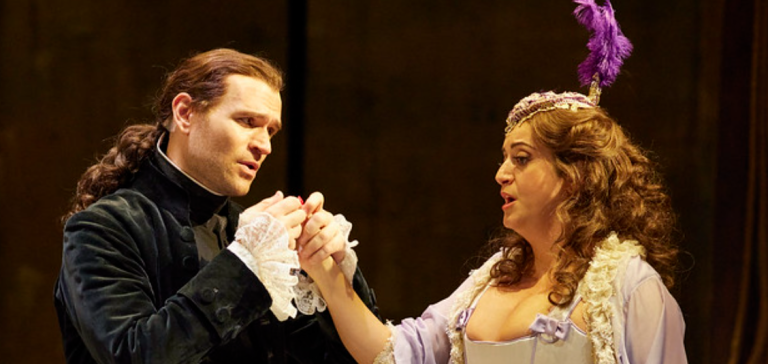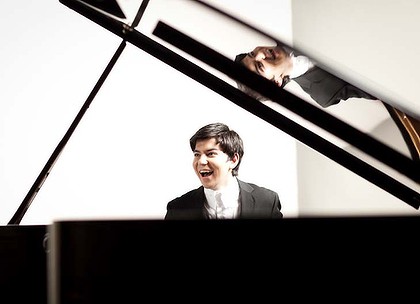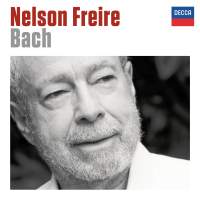Album Review: Pastoral Fables – Works For Cor Anglais And Piano/ Oguey And Da Costa/ ABC Classics

Pastoral Fables, a new album from ABC Classics is a collection of eight Romantic works, mostly transcribed by Alexander Oguey for cor anglais and piano, performed by Oguey, cor anglais (Marigaux, Paris) and Neal Peres Da Costa, grand piano (Viennese action grand piano after an 1868 model by J B Streicher and reproduced by Paul McNulty).
A striking (pardon the pun) feature of this combination is that while the cor anglais is known for its sustained lyrical attributes, this model of the piano, has a contrasting short-lived sound. As described in the booklet notes, it operates via the prellzungen mechanism devised by J A Stein (Nanette Stein- Streicher’s father) creating “an especially crisp attack of sound followed by an immediate, very rapid decay.” It is a pairing of opposites, but one that allows the beauty of each instrument to shine. Add to that the limited solo repertoire that is available for the cor anglais and its rare appearance in solo performance and Pastoral Fables becomes an anthology full of discovery.
Thought to date from around 1720, the cor anglais, with its distinctive, rich, Romantic sound, remained firmly within the bounds of the orchestra until the 20th century, when composers recognised the soloistic potential of this instrumental wallflower and began to show it off. Little music from the Romantic era was dedicated to the cor anglais, though numerous composers included it in their orchestral writing. Gluck included a pair in Orfeo ed Euridice; Joseph Haydn used it at the Esterházy court, including the Symphony no.22 (‘The Philosopher’, 1764); Salieri featured it in his Requiem and its prominence in the bel canto operas of Rossini, Bellini and Donizetti is proof that it was also considered to complement the voice. Verdi called for the cor anglais in his grand operas Un ballo in maschera, Don Carlos and Otello; Wagner used it in the overture to Der fliegende Holländer, in Tannhäuser, Lohengrin and Tristan und Isolde. The singing style of the cor anglais and its dramatic ability to colour pastoral scenes, tragedy and nostalgia, gave it an established role in the orchestral family across Europe, in Germany, France, Italy and Russia.
The opening work on the disc, Beethoven’s Sonata in F major opus 17, is a daring showpiece written for horn and piano. The attention-grabbing solo statement from the cor anglais may as well be saying “Listen to me! This is my sound!” It is answered deftly by the piano, crisp with ornamentation and arpeggiated chords. Both Oguey and Da Costa gleefully exploit the technical demands of the sonata. Beethoven was one of the few Romantic composers who wrote for the cor anglais, albeit as a chamber instrument and so the inclusion of this transcription is apt.
Both Berlioz and Wagner were influential in realising the pastoral potential of the cor anglais. Continuing this theme, Pastoral Fables features Alpenkuhreigen, from Schumann’s dramatic poem Manfred opus 115, the only inclusion on this album which was written specifically for the cor anglais. This is an unaccompanied folk-like tune portraying a shepherd playing as he watches his cows. Byron’s text which is usually recited with the music is published with the CD notes in both German and English. Oguey conveys a great deal in this 2-minute cameo. Opening with a sleek, soothing rising motif and finely shaded tempi, he breaks into a gamboling theme that calls and echoes, before ending imperceptibly on the mediant of the scale, segueing in the same key, into Schumann’s other dreamy masterpiece Träumerei from Kinderszenen opus 15 which reprises the opening notes of Alpenkuhreigen. This adroit sequence is followed by Schumann’s Abendlied no 12 from opus 25 which also begins with a rising fourth, played with throbbing beauty of line by Oguey and unobtrusive support from Da Costa.
In contrast to this idyllic mood, Schumann’s Sonata in A minor opus 105 originally written for the violin and piano, introduces a note of anxiety and melancholy, well adapted to the expressive capabilities of the cor anglais and piano. Along with Neal Peres Da Costa’s performance at the keyboard, the dialogue created by the two instruments is one of a simmering restlessness. The contrast between the two instruments is especially evident in the second movement of this sonata, Allegretto and the third movement Lebhaft is most entertaining as they duel over the canonic themes like sworn adversaries!
Despite Brahms’ penchant for the lower registers of voice and instrument, he wrote nothing for the cor anglais. Oguey and Da Costa have given us the next best thing in transcriptions of Brahms’ Sonata for clarinet or viola and piano, opus 120 no 2 and two of his songs, Wiegenlied opus 49 no 4 and Die Mainacht, opus 43 no 2. Although the sonata opens with a sense of intimacy and introspection, it provides a foil for the many moments of drama and heroism performed by Oguey and Da Costa with full-blooded intensity of dynamic variation and timbre, most notably in the second movement, the Allegro appassionata.
The two final adaptations of lieder are a nod to the confluence of voice and cor anglais, recognised by the great composers of opera as noted previously.
The CD booklet accompanying Pastoral Fables contains comprehensive notes on the music, the instruments, the performers and insights into the arrangements. The cover is a calming painting of a lake viewed through a sylvan glade, by 18th century Swiss artist Maximilien de Mouron. The recording was made at the Sydney Conservatorium of Music in October 2016 and April 2017.
Pastoral Fables is cleverly curated and transcribed, highlighting the possibilities of two intriguingly contrasting instruments which yet complement each other as equals. Oguey and Da Costa are keeping the performance practices of the 19th century alive, and with the benefits of improved contemporary research methods, demonstrate how this music would have been played on these instruments at that time. Truly 21st century insights into 19th century style. Their exquisite soloism and technical mastery are combined with sophisticated interpretation and emotional insight. Yet throughout, they are firmly equal partners in performance.
Shamistha de Soysa for SoundsLikeSydney©







